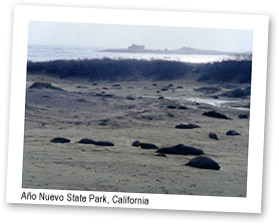|
Online exhibits : Special exhibits : Fossils in our parklands
Año Nuevo State Park, California
by Dave Haasl and Nick Pyenson
Año Nuevo, on the California coast about 20 miles north of Santa Cruz, is probably best known as the site of the largest mainland breeding colony of the northern elephant seal, but its geology is also of interest. Most noticeable are the sedimentary rocks of the Monterey Formation exposed in sea cliffs along the coastline and on Año Nuevo Island. These rocks originated as sedimentary clay and silt laid down beneath the sea some 12 or 13 million years ago. The Monterey Formation underlies much of Año Nuevo and covers a large area of coastal California. It contains microfossils and an abundance of fossil shells. Particularly exciting are the fossil whales and dolphins, the large numbers of finely preserved crabs, as well as kelps and other large soft-bodied seaweeds, which are seldom found as fossils elsewhere. |
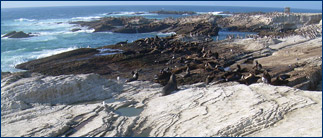 |
 |
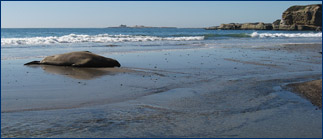 |
 |
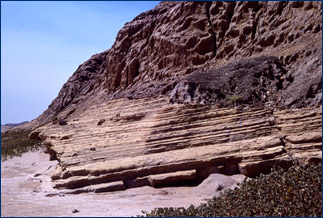 |
 |
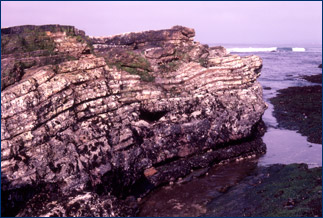 |

Click on any image to see an enlargement. Top left: Sea lions and seabirds relax on exposures of the Monterey Formation on Año Nuevo Island. Top right: A lone elephant seal on the beach at Año Nuevo. Bottom: Two views of Monterey Formation exposures at Año Nuevo. |
UCMP involvement
In 1987, Brian Fadely, a UC Santa Cruz graduate student, stumbled across what he thought was a cow skull eroding out of the Monterey Formation on Año Nuevo Island. Fadely reported the find to Frank Perry, a local expert on regional paleontology, who recognized the fossil as the partial skeleton of a small baleen whale (otherwise known as a mysticete). Perry, with the help of Fadely, excavated the fossil remains and donated them to the UC Santa Cruz Long Marine Lab for display for many years. Recently, the fossil was transferred to the collections of UCMP.
At UCMP, while the whale skull and skeleton were being prepared, tiny fossil molluscs (clams and snails) were discovered attached to the bones. Then UCMP graduate student Nicholas Pyenson and UCMP Museum Scientist David Haasl determined that this association represented a fossilized example of a whale-fall — a collection of deep-sea organisms that survives on the carcass of a dead whale that falls to the ocean floor. Pyenson and Haasl pointed to several lines of evidence. First, the rocks on Año Nuevo Island represent deep-sea sediments, pointing to an original burial nearly 1000 m below sea-level during the middle of the Miocene epoch, 11-15 million years ago. Second, both the skeleton of the whale and the position of the molluscs on it were consistent with the arrangements known from modern-day examples of whale-falls. Finally, the fossil molluscs that they identified belong only to a group of living ones that are specific to modern whale-falls, forming a unique biological community.
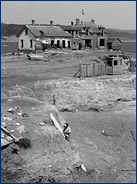 |
 |
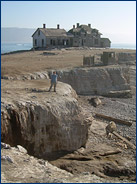 |
 |
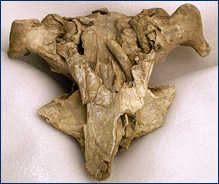 |
 |
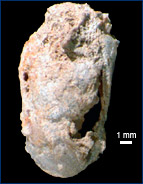 |

Click on any of the first three images to see an enlargement. From left, excavation of fossil whale bones from a cliff on Año Nuevo Island, 1987; Dave Haasl at the same locality in 2007; the whale skull on which small molluscs were discovered; a small bivalve found on the skull. |
When whales die and fall to the sea floor in deep water, they represent a substantial food source in an otherwise deserted seafloor. The dead whale is then quickly colonized by a host of scavengers and other organisms that either eat or inhabit the carcass and its bones. During the later stages of decomposition, the whale carcass is colonized by bacteria that live off of the sulfides produced by the decomposition of proteins. Other organisms, like the molluscs found on this whale fossil, are also found in other sulfide-rich environments, such as deep-sea hydrothermal vents and methane seeps. While widely reported from the seafloor around the world, this biological community is only now being recognized in the fossil record. This specimen is the first known example from the fossil record of California, and the youngest yet documented in the world. Its discovery shows us how the evolution of whales was connected not only with events in the oceans but also on the seafloor, where their carcasses allowed for the evolution of a completely novel ecological niche.
In the collections
Referred to as Fadely's Lighthouse Cetothere, the whale described above has 12 very small invertebrates associated with it — primarily bivalves and at least one gastropod. Six have been identified as vesicomyid bivalves, two as possible nuculoid bivalves, three identified just to bivalve, and one gastropod. None of these are very well preserved and they cannnot with confidence be identified beyond class or family taxon level.
Note: Collection of fossil material is illegal unless done under a permit from the California Department of Parks and Recreation. If you think you have found a fossil on state park lands, please contact a park representative.
More information
See the Año Nuevo State Park website.
Pyenson, N.D., and D.M. Haasl. 2007. Miocene whale-fall from California demonstrates that cetacean size did not determine the evolution of modern whale-fall communities. Biology Letters 3(6):709–711. DOI: 10.1098/rsbl.2007.0342
